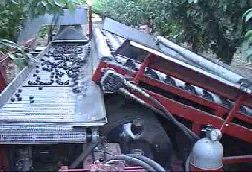This page has been archived and is being provided for reference purposes only. The page is no longer being updated, and therefore, links on the page may be invalid.
|
|
Cherry Harvester Helps Kids Learn Mechanical EngineeringBy Judy McBrideMarch 27, 2001 Most kids would love to operate the prototype cherry harvester developed by Agricultural Research Service engineer Donald L. Peterson. It propels itself through a live orchard while the operator uses joy sticks to extend and retract a mechanical arm that shakes sweet cherries loose from their branches and drops them on a soft catching surface draped over rollers. The rollers gently push the cherries onto a conveyor belt. There, the cherries ride under a fan that blows away unwanted leaves before they roll into a packing box. It’s better than a video game. And the harvest tastes great. LEGO Dacta–the company that makes LEGO blocks--thought Peterson’s harvester would spark imagination in would-be engineers. It is highlighted as the “Machine On the Go” in the company’s newest mechanical engineering set of building plans. Each set is designed for classroom use by middle- and high-school students to convey engineering principles and techniques, according to project manager Tracy Dagon. Dagon and her colleagues at LEGO Dacta worked with teachers to design the mechanical engineering set. They included action footage of Peterson’s harvester in a video CD that accompanies the lesson plans. Peterson designed and built the prototype harvester at the agency’s Appalachian Fruit Research Station in Kearneysville, W.Va. Members of the tree fruit research commission in Washington state--where most of the country’s sweet cherries are grown--enlisted Peterson’s help in converting to mechanical harvesting because the seasonal labor supply is becoming more questionable. First-year field trials in Washington last summer produced very promising results, according to Peterson. The percentage of damaged fruit was only slightly higher with his strange-looking machine than with hand harvesting. He is beginning to build the harvester’s mate--a mirror version that will ride down the other side of the orchard row catching cherries from branches on the far side. Growers will have to train their trees to be compatible with the harvester, and use a growth regulator that allows the cherries to more easily detach from their stems. ARS is the chief scientific research agency in the U.S. Department of Agriculture. Scientific contact: Donald L. Peterson, ARS Appalachian Fruit Research Station, Kearneysville, W.Va., phone (304) 725-3451, ext. 324, fax (304) 728-2340, dpeterso@afrs.ars.usda.gov. |



